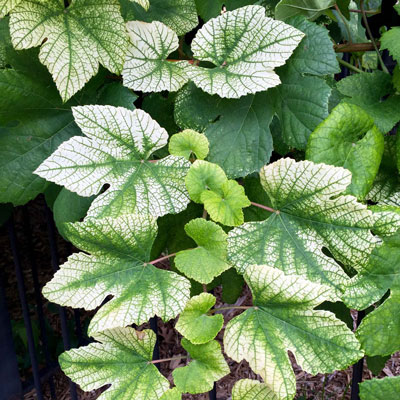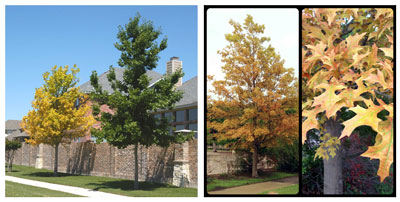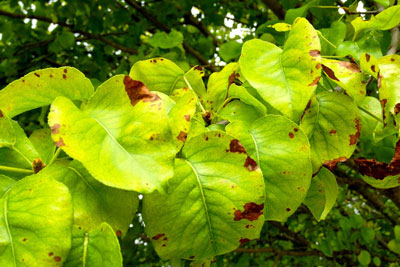Identifying, Treating Iron Deficiency in Plants
Iron is a soil-borne nutrient element that plants use in the creation of chlorophyll. Since almost all life depends on chlorophyll, iron is rather critical to us all. Here are ways first to identify iron deficiency, then to deal with it.
Why iron deficiency happens…
Plants take iron into their systems from the soil through their roots. However, it must be soluble in water for that to happen. Under alkaline conditions iron converts to an insoluble form. That’s why iron deficiency is far more common in the western 75 percent of Texas (from I35 westward) than it is in East Texas.

Photo: Grape vine shows pale yellow leaves with dark green veins, most prominently displayed on newest growth first.
Identifying iron deficiency…
There are three key items for recognizing iron deficiency.
1. Iron deficiency (chlorosis) will always appear on the newest growth (leaves at the growing tips of the branches) first.
2. Leaves will at first be lighter green or yellow, with veins remaining dark green the longest.
3. Leaves do not fall from the plant. In fact, they may eventually turn almost white, but they will remain in place.
Similar problems that get misdiagnosed as iron deficiency…

Photo: Mulberry shows water deficiency in summer. Leaves are yellowed with dark green veins, so that part is right. But it’s most prominent on the older leaves farthest from the growing tips.
Drought symptoms on shade trees in summer. Older leaves’ veins may turn yellow (mulberries), or entire leaves (many species) may turn yellow overall, and leaves will fall prematurely.
Treating iron deficiency once it has been identified…
• If you are gardening in an area with alkaline soils, whenever possible you should avoid plants known to have high needs of iron. Common plants that frequently show iron deficiency include azaleas, gardenias, waxleaf ligustrums, cleyeras, wisterias and dogwoods.

Left photo: Northern pin oak mistakenly planted for a Shumard red oak. Side by side placement with a true Shumard red oak allows you to see how pin oaks fare in Texas’ alkaline clay soils. Click photo for a larger view. Right photo: Another pin oak that showed these extreme symptoms two years ago is now dead.
Do not attempt to grow medium-sized and large shade trees that need a great deal of iron if you are in an area with alkaline soils and irrigation water. That list includes slash and loblolly pines, water oaks, willow oaks, pin oaks, cherry laurels, Savannah and American hollies and its hybrids such as East Palatka. You simply will not be able to apply enough iron to keep them going.
• Use combination iron/sulfur materials to supply soluble iron and to help acidify the soil via the sulfur. Note that your plants don’t necessarily need the sulfur. They just need the effects the sulfur has in lowering the soil pH.
• Add chelated iron products for longer-term correction of iron deficiency. The chelating provides buffering action against the alkalinity of the soil.
• Iron sprays are available that can give quicker green-up, but be sure you read and follow all the directions carefully.
• Certified arborists have products that allow them to inject iron directly into the vascular systems of trees’ trunks. However, please remember my warning: it is expensive, if not impossible, to sustain an iron-dependent shade tree year after year.

Photo: Ornamental pear foliage is beginning to show the scorch that accompanies yellowing. It will soon be too late to turn this around.
IMPORTANT WARNING: Iron products will stain masonry and painted surfaces, so be very careful when applying them near walks, drives, patios, fences, walls and houses.
A friend of mine once asked me to swing by her new house to look at her shrubs. Iron hadn’t helped green them up. To her chagrin, she had been trying to get the yellow out of gold spot euonymus. In the process, she had completely stained her entire patio with the spray.
